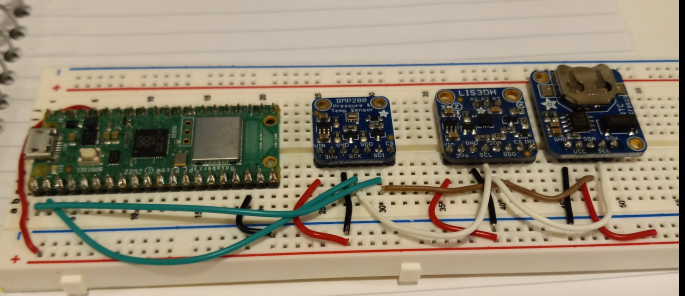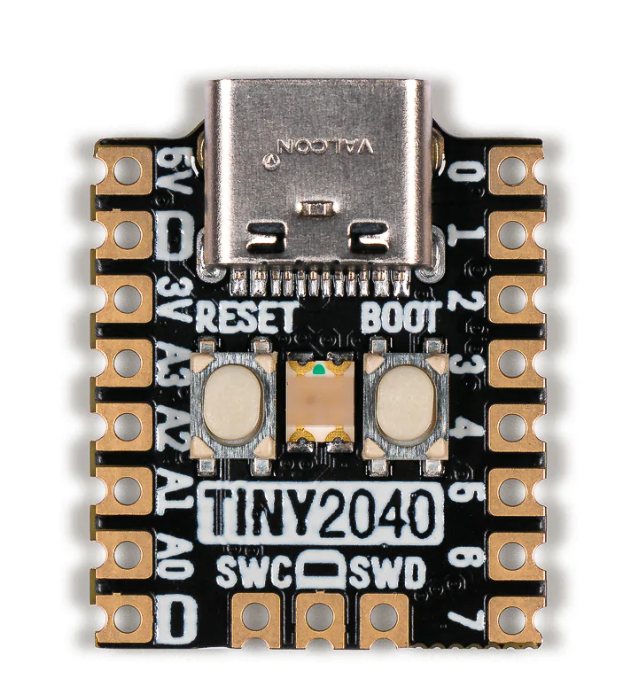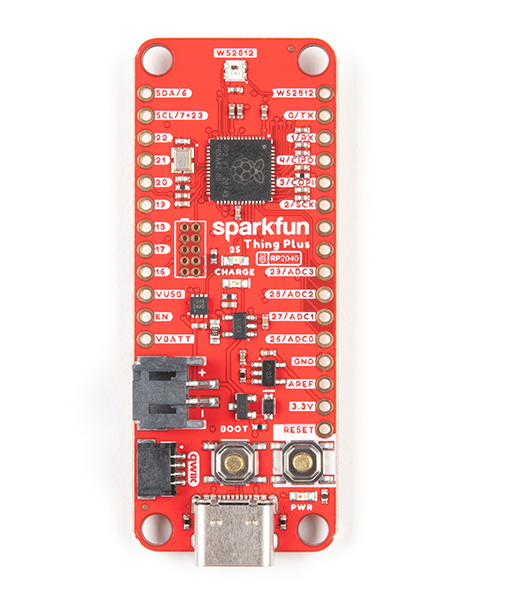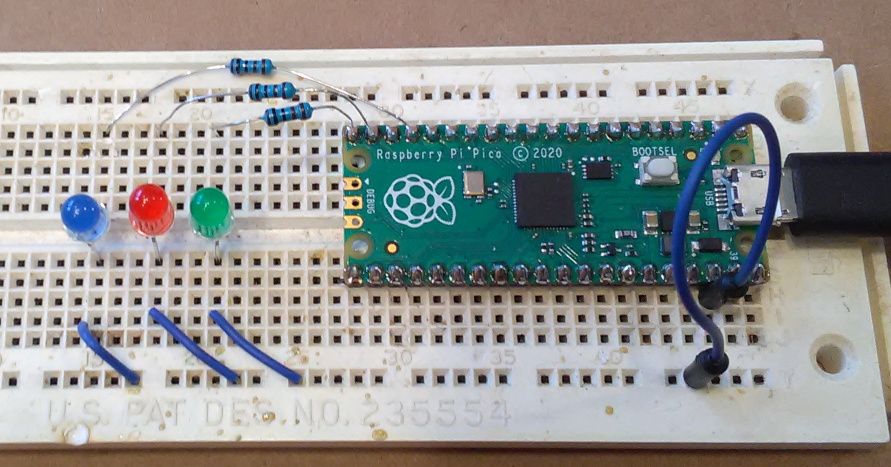Raspberry Pi Pico
11/01/2022
The Raspberry Pi Foundation has released an updated version of the Pi Pico. This updated version, the Pico W, has a WiFi chip. This allows the board to be on a WiFi network. Sample code is available and simple apps are available that allow for controlling the board via a web page. This is very exciting as it is a lot easier to control the board from a page on a cell phone that via jumpers and buttons. I have done a bit of testing of these boards. While the range might not be that great, the fact that you can get IP is very handy and you can connect to a router which can give you plenty of range. The chip looks like this:

Here are some instruments wired up to the Pico W. Note these chips are hard to find due to high demand by makers.

Other variants are now available as well. I have a couple of the Pimoroni boards which have either 16Mb or 8Mb of RAM. The Tiny is really small, great for use in a balloon or rocket.

12/22/2021
The stock Pi Pico board is pretty sparse on hardware as discussed below. This is more of a test board that users can experiment with and good for marketing.
To be really useful, the Pico needs to have more storage space (because it is used for code and the python interpreter as well, and also data files). The ability to run off batteries would be good as well as a micro-sd storage option.
Well, there are two boards that I bought from Adafruit and Sparkfun that go a long way to address the problems.
Here is the Sparkfun board:

Features of the Sparkfun
SparkFun Thing Plus – RP2040 Features
- Raspberry Pi Foundation’s RP2040 microcontroller
- 16MB QSPI Flash Memory
- JTAG PTH Pins
- Thing Plus (or Feather) Form-Factor:
- USB-C Connector:
- USB 1.1 Host/Device functionality
- 2-pin JST Connector for a LiPo Battery (not included):
- 500mA charging circuit
- Qwiic Connector
- Buttons:
- Boot
- Reset
- LEDs:
PWR– Red 3.3V power indicatorCHG– Yellow battery charging indicator25– Blue status/test LED (GPIO 25)WS2812– Addressable RGB LED (GPIO 08)
- Four Mounting Holes:
- 4-40 screw compatible
- Dimensions: 2.3″ x 0.9″
Having the super amount of flash (16Mb) is great for storing data on the device as well as code. The micro-sd card reader is great for long term and large file storage. I bought two of these boards and am doing some early testing as time permits.
The second board that is almost as good is from Adafruit. This board has 8Mb of flash and no micro-sd. The lack of micro-sd is an impediment for me, as I would have to connect the device to read the flight data out. I have one of these board and have loaded and run a bit of circuit python on it. Here is a shot of the board:

3/4/2021
The Raspberry Pi Foundation recently announced a new member of their Raspberry Pi family of products.
Unlike the previous items, this one is not running Linux, but it oriented toward the maker and IOT audience. The new Pi Pico boards were hard to find but I found a local dealer who let me have them for a good price.
Youtube provided a wealth of information including some project guides. I built a simple thermometer with some leds based on one of the videos from Jeff Geerling. Below is an image of my little test board.
There is very little on the board, which is reflected partially in the price of less than $5 list. You see there is the new custom processor, a memory chip, and a few odds and ends.
The board can be programmed in C/C++ and also in python. At the time of this writing I have only used the python/thonny system. I have not used any arduino based tools yet.

Specifications
21 mm × 51 mm form factor
RP2040 microcontroller chip designed by Raspberry Pi in the UK
Dual-core Arm Cortex-M0+ processor, flexible clock running up to 133 MHz
264KB on-chip SRAM
2MB on-board QSPI Flash
26 multifunction GPIO pins, including 3 analogue inputs
2 × UART, 2 × SPI controllers, 2 × I2C controllers, 16 × PWM channels
1 × USB 1.1 controller and PHY, with host and device support
8 × Programmable I/O (PIO) state machines for custom peripheral support
Supported input power 1.8–5.5V DC
Operating temperature -20°C to +85°C
Castellated module allows soldering direct to carrier boards
Drag-and-drop programming using mass storage over USB
Low-power sleep and dormant modes
Accurate on-chip clock
Temperature sensor
Accelerated integer and floating-point libraries on-chip
This is a two core processor, which is novel in this space. The ESP32 have two core but I have not seen any other low cost dev boards like this with two cores. Pretty cool to have two cores. There are also a couple of state machines that can be programmed to run IO subsystems at high speed. The board is lacking lots of the goodies I have come to expect from the feather types of machines, such as battery charging and battery connectors. There are a couple of feather type boards in the works.
The feather types of boards will possibly be of greater use for the rocket and balloon testing boards. Larger flash memory will allow potentially for data to be written to the flash
As of right now, this board is not very useful for my balloon and rocket work compared to the feather boards and arduino boards. Time will tell if this chip works out, but it has some potential for sure.
